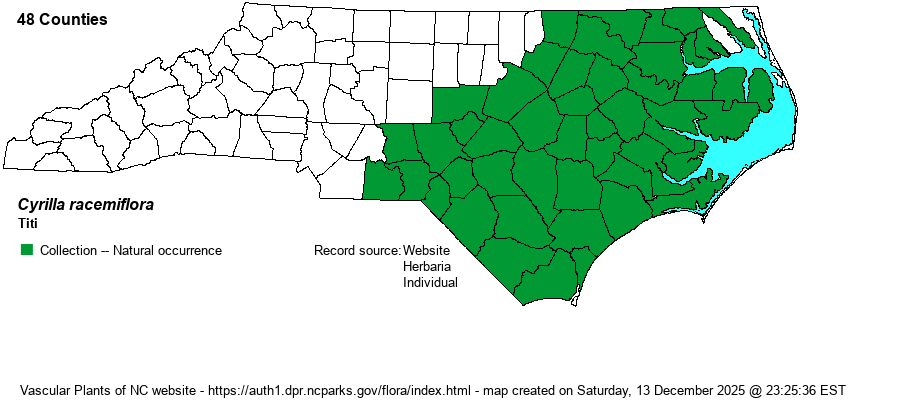| Section 6 » Order Ericales » Family Cyrillaceae |
Show/Hide Synonym
| taxonName | relationship | relatedTaxonName | relatedTaxonRefText | relComments |
|---|
| Cyrilla racemiflora | < | Cyrilla racemiflora | Kubitzki in Kubitzki (2004). | | | Cyrilla racemiflora | > | Cyrilla racemiflora var. racemiflora | Fernald (1950) | | | Cyrilla racemiflora | > | Cyrilla racemiflora var. subglobosa | Fernald (1950) | | |
|
|
|
|
|
|
|
| Cyrilla racemiflora | < | Cyrilla racemiflora | Flora of North America (1993b, 1997, 2000, 2002a, 2002b, 2003a, 2004b, 2005, 2006a, 2006b, 2006c, 2007a, 2009, 2010) | | | Cyrilla racemiflora | < | Cyrilla racemiflora | Godfrey and Wooten (1979, 1981) | | | Cyrilla racemiflora | < | Cyrilla racemiflora | | | | Cyrilla racemiflora | < | Cyrilla racemiflora | Wunderlin & Hansen Flora of Florida (3) | | | Source: Weakley's Flora |
|
| Author | L. | |
| Distribution | Present over the entire Coastal Plain, ranging inland only to the extreme eastern edge of the Piedmont – west to Warren, Wake, Chatham, Montgomery, and Anson counties. Apparently no isolated county records farther westward.
This is a Coastal Plain species ranging north only to southeastern VA, and then south to central FL and eastern TX. It rarely is found inland of Fall Lines in any state.
| |
| Abundance | Common and widespread in the Coastal Plain, locally dominant in some places. Rare to locally uncommon in the eastern edge of the Piedmont (most widespread near the Pee Dee River and tributaries). | |
| Habitat | This is a classic woody pocosin species, being found in a wide variety of bay forests, blackwater creekbanks, streamhead pocosins, swamps, lake and pond margins, and wet thickets, typically in acidic soils. |
| Phenology | Blooms from May to July, and fruits in September and October. | |
| Identification | This is a familiar semi-evergreen tree of the Coastal Plain, it growing mainly just to 20-25 feet tall. Leaves tend to remain on the tree until mid- to late winter; some turn red in fall. The leaves are shiny above, oblanceolate, with entire margins and a mostly rounded tip; they average about 3 inches long and less than 1-inch wide. Most people can identify this common wetland tree just by the leaves, but when in bloom it cannot be overlooked or confused. The inflorescence is a very narrow spike of small white flowers, often 3-4 inches long. A number of such spikes emerge from the ends of the branches; when in bloom, trees often turn “white”! | |
| Taxonomic Comments | None, though a few old references named several varieties for it.
| |
| Other Common Name(s) | Swamp Titi, Swamp Cyrilla, Leatherwood (typically in use for Dirca palustris) | |
| State Rank | S5 | |
| Global Rank | G5 | |
| State Status | | |
| US Status | | |
| USACE-agcp | FACW link |
| USACE-emp | FACW link |

